Pytest API Testing with FastAPI, SQLAlchemy, Postgres - 1/2
Building APIs is easy. Testing them is harder.
API testing involves multiple components and strays into the realm of integration testing.
APIs form an interface between the real world consumers of data and a data store.
So how do you test this interaction of components?
How do you test that your API correctly handles the incoming payload and return values?
What about making sure your API returns correct HTTP response codes?
Should you use a real database or mock the queries? Does that create a strong coupling with the source code?
What about an in-memory database like SQLite or TinyDB?
In this Pytest API Testing Masterclass, we’ll answer all your API testing questions.
We’ll go deep into building our own Mortgage Calculator API with FastAPI, SQLAlchemy, Postgres, and Pytest.
We’ll test our API using recommended Pytest functionality like fixtures, setup, teardown, and hooks.
You’ll learn to maintain a clean database state between tests and use Pytest hooks to manage sessions and fixtures to handle common objects across tests.
There’s a lot packed into this article so I encourage you to get your IDE out and follow along.
To avoid this article being insanely long I’ve split it up into 2 parts, to be published sequentially.
Hope you’re excited, let’s begin.
Why is API Testing Important?
So why is API testing important?
Isn’t it enough to build the API and hope it works? Maybe run a few checks on Postman?
That’s OK for your pet projects, but not when building enterprise-level software.
The cost of failure is too high, especially when dealing with user data.
Let’s understand why API testing is important and should be well handled during the development process.
- Ensures Reliability: API testing helps verify that the API functions as expected.
- Detects Issues Early: API testing can identify and fix issues before they become more significant problems, saving time and resources.
- Validates Data Integrity: API testing ensures that the data exchanged between systems is accurate and consistent, maintaining data integrity across different services.
- Enhances Security: API testing helps identify potential security vulnerabilities, such as unauthorized access or data breaches, and address them proactively.
- Improves Performance: API testing ensures the API can handle the expected load.
- Facilitates Automation: API testing increases confidence in CI/CD pipelines and automated release processes.
- Reduces Manual Testing: Automated API tests reduce the need for extensive manual testing, freeing up resources and allowing testers to focus on more complex test scenarios.
- Ensures Compliance: API testing helps ensure that the API complies with industry standards and regulations, which is crucial for industries like finance and healthcare.
- Improves Documentation: Creating and maintaining API tests often leads to better-documented APIs, making it easier for you and your team to understand and use them correctly.
- Regression and Smoke Tests: Automated API tests can ensure the API still works as expected when new changes are introduced, reducing regression. It also ensures critical paths (e.g. User Registration, Checkout) are checked and working at all times.
Most importantly, robust API testing allows you to sleep peacefully at night.
Now that you’re on-board and understand the need for robust API testing, let’s dive into the problem statement.
Problem Statement
Let’s examine the problem statement or the Statement of Work.
Build a Mortgage Calculator that calculates the monthly payment for an interest-only and repayment-type mortgage on a property.
As with anything in coding, you must get a clear problem statement to know exactly what you’re solving.
We’ll make a few assumptions here for simplicity but I encourage you to clarify every assumption in the real world.
If you’re not familiar with these types of mortgages this article covers the differences.
In short, the calculation for each is different.
In this example, we’ll build CRUD routes (Create, Read, Update, and Delete) for Properties and Mortgages. We’ll also have a custom calculations to calculate the monthly mortgage payment in the case of each - interest only and repayment mortgages.
As you can see in the ORM diagram below, mortgages are linked to a property via property_id and can be of interest_only or repayment type.
Project Setup
Let’s get started with the coding.
Clone Repo
Clone the repository containing the example code or if you prefer to start from scratch you can do so by following the similar directory structure.1
2
3
4
5
6
7
8
9
10
11
12
13
14
15
16
17
18
19
20
21
22
23
24
25
26
27
28
29
30
31.
├── .gitignore
├── README.md
└── mortgage_calculator
├── app
│ ├── __init__.py
│ ├── crud
│ │ ├── mortgage_crud.py
│ │ └── property_crud.py
│ ├── custom
│ │ ├── calculations.py
│ │ └── db_queries.py
│ ├── database.py
│ ├── main.py
│ ├── models.py
│ ├── openapi.json
│ ├── routes.py
│ └── schemas.py
├── docker
│ └── docker-compose.yml
├── poetry.lock
├── pyproject.toml
└── tests
├── __init__.py
├── conftest.py
├── crud
│ ├── test_crud_errors.py
│ ├── test_mortgage_crud.py
│ └── test_property_crud.py
└── custom
└── test_mortgage_payments.py
We’ll be using Poetry to manage our dependencies and virtual environment so if you’re not familiar with Poetry I encourage you to start using it.
It’s a great tool that picks the best from pip, venv, conda, and others.
Install pyenv
I use pyenv to manage my Python versions but you can use any other tool.
Let’s set the Python version in the terminal to 3.121
2pyenv install 3.12
pyenv local 3.12
Install Dependencies
Our pyproject.toml file contains the dependencies.1
2
3
4
5
6
7
8
9
10
11
12
13
14
15
16
17
18
19
20
21
22
23
24
25
26
27
28
29[tool.poetry]
name = "mortgage-calculator"
version = "0.1.0"
description = "Mortgage Calculator API"
authors = []
readme = "README.md"
[tool.poetry.dependencies]
python = "^3.12"
fastapi = "0.111.0"
uvicorn = "^0.30.1"
pydantic = "^2.7.4"
httpx = "^0.27.0"
sqlalchemy-utils = "^0.41.2"
psycopg2 = "^2.9.9"
python-dotenv = "^1.0.1"
[tool.poetry.group.dev.dependencies]
pytest = "^8.2.2"
pytest-randomly = "^3.15.0"
ruff = "^0.5.0"
black = "^24.4.2"
isort = "^5.13.2"
pytest-cov = "^5.0.0"
[build-system]
requires = ["poetry-core"]
build-backend = "poetry.core.masonry.api"
To install dependencies, go ./mortgage_calculator/ and run,1
2
3poetry env use 3.12.3
poetry env info # Verify
poetry install
This will create a virtual environment in your directory and install the packages.
You can also do this interactively using poetry init .
Now that you have a working environment, go through the source code.
Source Code
First, let’s go through the code to understand it and then fire it up.
DB and DB Models
The SQL database models used are very simple and consist of only 2 tables — mortgages and properties.
We’ll store property details in the prpoperties table and associated mortgages in the mortgages table, joined by property_id .
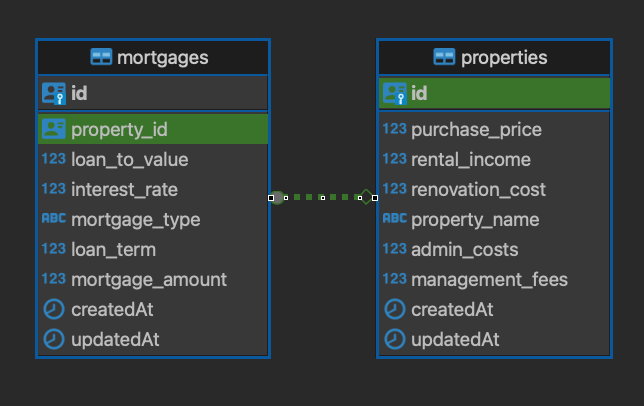
The below code contains the SQLAlchemy ORM models.
mortgage_calculator/app/models.py1
2
3
4
5
6
7
8
9
10
11
12
13
14
15
16
17
18
19
20
21
22
23
24
25
26
27
28
29
30
31
32
33
34
35
36
37
38
39
40
41
42
43
44
45
46
47
48
49
50
51
52
53import uuid
from enum import Enum
from sqlalchemy import TIMESTAMP, Column
from sqlalchemy import Enum as SQLAlchemyEnum
from sqlalchemy import ForeignKey, Numeric, String
from sqlalchemy.orm import relationship
from sqlalchemy.sql import func
from sqlalchemy_utils import UUIDType
from app.database import Base
class MortgageType(str, Enum):
interest_only = "interest_only"
repayment = "repayment"
class PropertyOrm(Base):
__tablename__ = "properties"
id = Column(UUIDType(binary=False), primary_key=True, default=uuid.uuid4)
purchase_price = Column(Numeric(10, 2), nullable=False)
rental_income = Column(Numeric(10, 2), nullable=False)
renovation_cost = Column(Numeric(10, 2), nullable=False)
property_name = Column(String(255), nullable=False)
admin_costs = Column(Numeric(10, 2), nullable=False)
management_fees = Column(Numeric(10, 2), nullable=False)
createdAt = Column(
TIMESTAMP(timezone=True), nullable=False, server_default=func.now()
)
updatedAt = Column(TIMESTAMP(timezone=True), default=None, onupdate=func.now())
mortgages = relationship("MortgageOrm", back_populates="property")
class MortgageOrm(Base):
__tablename__ = "mortgages"
id = Column(UUIDType(binary=False), primary_key=True, default=uuid.uuid4)
property_id = Column(UUIDType(binary=False), ForeignKey("properties.id"))
loan_to_value = Column(Numeric(5, 2), nullable=False)
interest_rate = Column(Numeric(5, 2), nullable=False)
mortgage_type = Column(SQLAlchemyEnum(MortgageType), nullable=False)
loan_term = Column(Numeric(5, 2), nullable=True)
mortgage_amount = Column(Numeric(10, 2), nullable=False)
property = relationship("PropertyOrm", back_populates="mortgages")
createdAt = Column(
TIMESTAMP(timezone=True), nullable=False, server_default=func.now()
)
updatedAt = Column(TIMESTAMP(timezone=True), default=None, onupdate=func.now())
Both tables have createdAt and updatedAt timestamps that auto-populate using SQLAlchemy in-built methods.
We’ve also included an Enum MortgageType to support interest_only and repayment type mortgages.
Here’s our database file. We’ll be using Postgres as our production database.
mortgage_calculator/app/database.py1
2
3
4
5
6
7
8
9
10
11
12
13
14
15
16
17
18
19
20
21
22
23
24
25
26
27
28
29
30
31
32
33
34
35
36
37
38import os
from dotenv import load_dotenv
from sqlalchemy import create_engine
from sqlalchemy.orm import declarative_base, sessionmaker
load_dotenv()
# Get Postgres Environment Variables
POSTGRES_HOST = os.getenv("POSTGRES_HOST")
POSTGRES_USER = os.getenv("POSTGRES_USER")
POSTGRES_PASSWORD = os.getenv("POSTGRES_PASSWORD")
POSTGRES_DB = os.getenv("POSTGRES_DB")
SQLALCHEMY_DATABASE_URL = (
f"postgresql://{POSTGRES_USER}:{POSTGRES_PASSWORD}@{POSTGRES_HOST}/{POSTGRES_DB}"
)
engine = create_engine(
SQLALCHEMY_DATABASE_URL,
)
SessionLocal = sessionmaker(autocommit=False, autoflush=False, bind=engine)
Base = declarative_base()
def get_db():
db = SessionLocal()
try:
yield db
finally:
db.close()
````
We’ve used a `.env` file but you can use [direnv](https://direnv.net/) or define these in the terminal if you prefer.
```env
POSTGRES_HOST="localhost"
POSTGRES_USER="myuser"
POSTGRES_PASSWORD="mypassword"
POSTGRES_DB="mydatabase"
Now let’s define our Pydantic Models which represent important entities like our Property Base Model, Mortgage Base Models and their CRUD Models.
Pydantic Models and Schemas
1 | `mortgage_calculator/app/schemas.py` |
In the above code snippet, we have
StatusEnumPropertyBaseModel— which contains the required payload fields, all optionalPropertyCreateModel- which inherits the BaseModel and requires all the fields.PropertyUpdateModelPropertyDeleteModelResponseModel
and similarly for Mortgages.
Why should you define models?
Our goal is to validate the incoming payload before translating it into SQLAlchemy Models that eventually write to the database.
And the same goes for responses and vice-versa.
This helps us maintain strong type validation so we’re not purely dealing with raw Python objects but rather strongly typed Pydantic Classes that handle errors and type checks beautifully.
Routing and Main File
Let’s look at the various routes we’ve defined.
Our main file looks like this.
mortgage_calculator/app/main.py1
2
3
4
5
6
7
8
9
10
11
12
13
14
15
16
17
18
19
20
21
22
23
24
25
26
27
28
29from fastapi import FastAPI
from fastapi.middleware.cors import CORSMiddleware
from app import models, routes
from app.database import engine
models.Base.metadata.create_all(bind=engine)
app = FastAPI()
origins = [
"http://localhost:3000",
]
app.add_middleware(
CORSMiddleware,
allow_origins=origins,
allow_credentials=True,
allow_methods=["*"],
allow_headers=["*"],
)
app.include_router(routes.router, tags=["MortgageCalculator"], prefix="/api/v1")
def root():
return {"message": "The API is LIVE!!"}
We included a simple health check endpoint to make sure the app has started and is working.
Our base endpoint is /api/v1 so on local host it would be http://localhost:port/api/v1 .
Next is our route file.
mortgage_calculator/app/routes.py1
2
3
4
5
6
7
8
9
10
11
12
13
14
15
16
17
18
19
20
21
22
23
24
25
26
27
28
29
30
31
32
33
34
35
36
37
38
39
40
41
42
43
44
45
46
47
48
49
50
51
52
53
54
55
56
57
58
59
60
61
62
63
64
65
66
67
68
69
70
71
72
73
74
75
76
77
78
79
80
81
82
83
84
85
86
87
88
89
90
91
92
93
94
95
96
97
98
99
100
101
102
103
104
105
106
107
108
109
110
111
112
113
114
115
116
117
118
119
120
121
122
123
124
125
126
127
128
129
130
131
132
133
134
135
136
137
138
139
140
141
142
143
144
145
146
147
148
149
150
151
152
153
154
155
156
157
158
159
160
161
162
163
164
165
166
167
168
169
170
171
172
173
174from typing import Dict
from fastapi import APIRouter, Depends, status
from sqlalchemy.orm import Session
import app.schemas as schemas
from app.crud.mortgage_crud import (
create_mortgage_crud,
delete_mortgage_crud,
get_mortgage_crud,
get_mortgages_crud,
update_mortgage_crud,
)
from app.crud.property_crud import (
create_property_crud,
delete_property_crud,
get_properties_crud,
get_property_crud,
update_property_crud,
)
from app.custom.db_queries import get_mortgage_payment
from app.database import get_db
router = APIRouter()
)
def create_property(
property: schemas.PropertyCreateModel, db: Session = Depends(get_db)
) -> schemas.PropertyResponseModel:
"""
Create a new property.
"""
return create_property_crud(payload=property, db=db)
)
def get_property(
property_id: str, db: Session = Depends(get_db)
) -> schemas.PropertyResponseModel:
"""
Get a property by ID.
"""
return get_property_crud(property_id=property_id, db=db)
)
def update_property(
property_id: str,
property: schemas.PropertyUpdateModel,
db: Session = Depends(get_db),
) -> schemas.PropertyResponseModel:
"""
Update a property by ID.
"""
return update_property_crud(property_id=property_id, payload=property, db=db)
)
def delete_property(
property_id: str, db: Session = Depends(get_db)
) -> schemas.PropertyDeleteModel:
"""
Delete a property by ID.
"""
return delete_property_crud(property_id=property_id, db=db)
)
def get_properties(db: Session = Depends(get_db)) -> schemas.PropertyListResponseModel:
"""
Get all properties.
"""
return get_properties_crud(db=db)
)
def create_mortgage(
mortgage: schemas.MortgageCreateModel, db: Session = Depends(get_db)
) -> schemas.MortgageResponseModel:
"""
Create a new mortgage.
"""
return create_mortgage_crud(payload=mortgage, db=db)
)
def get_mortgage(
mortgage_id: str, db: Session = Depends(get_db)
) -> schemas.MortgageResponseModel:
"""
Get a mortgage by ID.
"""
return get_mortgage_crud(mortgage_id=mortgage_id, db=db)
)
def update_mortgage(
mortgage_id: str,
mortgage: schemas.MortgageUpdateModel,
db: Session = Depends(get_db),
) -> schemas.MortgageResponseModel:
"""
Update a mortgage by ID.
"""
return update_mortgage_crud(mortgage_id=mortgage_id, payload=mortgage, db=db)
)
def delete_mortgage(
mortgage_id: str, db: Session = Depends(get_db)
) -> schemas.MortgageDeleteModel:
"""
Delete a mortgage by ID.
"""
return delete_mortgage_crud(mortgage_id=mortgage_id, db=db)
)
def get_mortgages(db: Session = Depends(get_db)) -> schemas.MortgageListResponseModel:
"""
Get all mortgages.
"""
return get_mortgages_crud(db=db)
def calculate_mortgage_payment(
mortgage_id: str, db: Session = Depends(get_db)
) -> Dict[str, str | float]:
"""
Retrieve the monthly payment for a given mortgage.
"""
return get_mortgage_payment(mortgage_id, db)
Property Routes
- Create Property (POST)
- Get Property (GET)
- Update Property (PATCH)
- Delete Property (DELETE)
- Get Properties (GET)
Similarly for mortgages.
All property routes are prefixed by /property while mortgage routes are prefixed by /mortgage .
Now you’ll notice something — in most FastAPI examples, the routing logic i.e validating the payload and writing to the database happens within this file.
That’s OK for small applications but as you grow more complex your routing logic gets complicated, hence it’s a good idea to split this out into a separate file.
You’ll see why shortly.
CRUD Logic
mortgage_calculator/app/crud/property_crud.py1
2
3
4
5
6
7
8
9
10
11
12
13
14
15
16
17
18
19
20
21
22
23
24
25
26
27
28
29
30
31
32
33
34
35
36
37
38
39
40
41
42
43
44
45
46
47
48
49
50
51
52
53
54
55
56
57
58
59
60
61
62
63
64
65
66
67
68
69
70
71
72
73
74
75
76
77
78
79
80
81
82
83
84
85
86
87
88
89
90
91
92
93
94
95
96
97
98
99
100
101
102
103
104
105
106
107
108
109
110
111
112
113
114
115
116
117
118
119
120
121
122
123
124
125
126
127
128
129
130
131
132
133
134
135
136
137
138
139
140
141
142
143
144from fastapi import Depends, HTTPException, status
from sqlalchemy.exc import IntegrityError, SQLAlchemyError
from sqlalchemy.orm import Session
import app.models as models
import app.schemas as schemas
from app.database import get_db
def create_property_crud( payload: schemas.PropertyCreateModel, db: Session = Depends(get_db)):
try:
new_property = models.PropertyOrm(**payload.model_dump())
db.add(new_property)
db.commit()
db.refresh(new_property)
property_data = schemas.PropertyModel.model_validate(new_property)
return schemas.PropertyResponseModel(
status=schemas.Status.Success,
message="Property created successfully.",
data=property_data,
)
except IntegrityError:
db.rollback()
raise HTTPException(
status_code=status.HTTP_409_CONFLICT,
detail="A property with the given details already exists.",
)
except Exception as e:
db.rollback()
raise HTTPException(
status_code=status.HTTP_500_INTERNAL_SERVER_ERROR,
detail=f"An error occurred while creating the property: {str(e)}",
)
def get_property_crud(property_id: str, db: Session = Depends(get_db)):
property_data = (
db.query(models.PropertyOrm)
.filter(models.PropertyOrm.id == property_id)
.first()
)
if not property_data:
raise HTTPException(
status_code=status.HTTP_404_NOT_FOUND,
detail="Property not found.",
)
try:
return schemas.PropertyResponseModel(
status=schemas.Status.Success,
message="Property retrieved successfully.",
data=schemas.PropertyModel.model_validate(property_data),
)
except SQLAlchemyError as e:
raise HTTPException(
status_code=status.HTTP_500_INTERNAL_SERVER_ERROR,
detail="An unexpected error occurred while retrieving the property.",
) from e
def update_property_crud( property_id: str, payload: schemas.PropertyUpdateModel, db: Session):
property_query = db.query(models.PropertyOrm).filter(
models.PropertyOrm.id == property_id
)
db_property = property_query.first()
if not db_property:
raise HTTPException(
status_code=status.HTTP_404_NOT_FOUND, detail="Property not found."
)
try:
# Prepare update data from the payload, only including fields that are set
update_data = payload.model_dump(exclude_unset=True)
if update_data:
property_query.update(update_data, synchronize_session="evaluate")
db.commit()
db.refresh(db_property)
# Convert the updated ORM model back to a Pydantic model
return schemas.PropertyResponseModel(
status=schemas.Status.Success,
message="Property updated successfully.",
data=schemas.PropertyModel.model_validate(db_property),
)
else:
raise HTTPException(
status_code=status.HTTP_400_BAD_REQUEST,
detail="No valid fields provided for update.",
)
except IntegrityError as e:
db.rollback()
raise HTTPException(
status_code=status.HTTP_409_CONFLICT,
detail="A property with the given details already exists.",
) from e
except SQLAlchemyError as e:
db.rollback()
raise HTTPException(
status_code=status.HTTP_500_INTERNAL_SERVER_ERROR,
detail=f"An error occurred while updating the property: {str(e)}",
) from e
def delete_property_crud(property_id: str, db: Session = Depends(get_db)):
try:
property_query = db.query(models.PropertyOrm).filter(
models.PropertyOrm.id == property_id
)
property_ = property_query.first()
if not property_:
raise HTTPException(
status_code=status.HTTP_404_NOT_FOUND,
detail=f"No property found with ID: {property_id}",
)
property_query.delete(synchronize_session=False)
db.commit()
return schemas.PropertyDeleteModel(
id=property_id,
status=schemas.Status.Success,
message="Property deleted successfully.",
)
except Exception as e:
db.rollback()
raise HTTPException(
status_code=status.HTTP_500_INTERNAL_SERVER_ERROR,
detail="An unexpected error occurred while deleting the property.",
) from e
def get_properties_crud( db: Session = Depends(get_db), limit: int = 10, page: int = 1, search: str = ""):
skip = (page - 1) * limit
properties = db.query(models.PropertyOrm).limit(limit).offset(skip).all()
return schemas.PropertyListResponseModel(
status=schemas.Status.Success,
message="Properties retrieved successfully.",
data=[
schemas.PropertyModel.model_validate(property_) for property_ in properties
],
)
Here we have the logic for Property CRUD operations.
There is a constant conversion from Pydantic object/model to SQLAlchemy ORM object and vice versa.
As mentioned above this ensures we’re always working with strongly type-checked classes.
You’ll also notice we’re handling errors like
- 404 — Object not found
- 409 — Conflict
- 500 — Internal Server Error (which is not great tbh)
- 200 — Successful response
- 201 — Created successfully
You can find the complete list of HTTP response codes here. In building enterprise-level APIs it’s very important to take this seriously and make sure it’s tested thoroughly.
Let’s look at how we’ve written the CRUD operations for mortgages.
mortgage_calculator/app/crud/mortgage_crud.py1
2
3
4
5
6
7
8
9
10
11
12
13
14
15
16
17
18
19
20
21
22
23
24
25
26
27
28
29
30
31
32
33
34
35
36
37
38
39
40
41
42
43
44
45
46
47
48
49
50
51
52
53
54
55
56
57
58
59
60
61
62
63
64
65
66
67
68
69
70
71
72
73
74
75
76
77
78
79
80
81
82
83
84
85
86
87
88
89
90
91
92
93
94
95
96
97
98
99
100
101
102
103
104
105
106
107
108
109
110
111
112
113
114
115
116
117
118
119
120
121
122
123
124
125
126
127
128
129
130
131
132
133
134
135
136
137
138
139
140
141
142
143
144
145
146
147
148
149
150
151
152
153
154
155
156
157from fastapi import Depends, HTTPException, status
from sqlalchemy.exc import IntegrityError, SQLAlchemyError
from sqlalchemy.orm import Session
import app.models as models
import app.schemas as schemas
from app.database import get_db
def create_mortgage_crud( payload: schemas.MortgageCreateModel, db: Session = Depends(get_db)):
try:
# Create a new mortgage object from the payload
new_mortgage = models.MortgageOrm(**payload.model_dump())
# Check whether the property exists in the DB
property_data = (
db.query(models.PropertyOrm)
.filter(models.PropertyOrm.id == payload.property_id)
.first()
)
if not property_data:
raise HTTPException(
status_code=status.HTTP_404_NOT_FOUND,
detail="Property not found.",
)
# Get Purchase Price of the property and calculate mortgage amount (LTV * Purchase Price)
purchase_price = float(property_data.purchase_price) # Convert to float
loan_to_value = float(new_mortgage.loan_to_value) # Ensure this is float
mortgage_amount = (purchase_price * loan_to_value) / 100
new_mortgage.mortgage_amount = mortgage_amount
db.add(new_mortgage)
db.commit()
db.refresh(new_mortgage)
# Validate the new mortgage object
mortgage_data = schemas.MortgageModel.model_validate(new_mortgage)
return schemas.MortgageResponseModel(
status=schemas.Status.Success,
message="Mortgage created successfully.",
data=mortgage_data,
)
except IntegrityError:
db.rollback()
raise HTTPException(
status_code=status.HTTP_409_CONFLICT,
detail="A mortgage with the given details already exists.",
)
def get_mortgage_crud(mortgage_id: str, db: Session = Depends(get_db)):
mortgage_data = (
db.query(models.MortgageOrm)
.filter(models.MortgageOrm.id == mortgage_id)
.first()
)
if not mortgage_data:
raise HTTPException(
status_code=status.HTTP_404_NOT_FOUND,
detail="Mortgage not found.",
)
try:
return schemas.MortgageResponseModel(
status=schemas.Status.Success,
message="Mortgage retrieved successfully.",
data=schemas.MortgageModel.model_validate(mortgage_data),
)
except SQLAlchemyError as e:
raise HTTPException(
status_code=status.HTTP_500_INTERNAL_SERVER_ERROR,
detail="An unexpected error occurred while retrieving the mortgage.",
) from e
def update_mortgage_crud( mortgage_id: str, payload: schemas.MortgageUpdateModel, db: Session):
mortgage_query = db.query(models.MortgageOrm).filter(
models.MortgageOrm.id == mortgage_id
)
db_mortgage = mortgage_query.first()
if not db_mortgage:
raise HTTPException(
status_code=status.HTTP_404_NOT_FOUND, detail="Mortgage not found."
)
try:
# Prepare update data from the payload, only including fields that are set
update_data = payload.model_dump(exclude_unset=True)
if update_data:
mortgage_query.update(update_data, synchronize_session="evaluate")
db.commit()
db.refresh(db_mortgage)
# Convert the updated ORM model back to a Pydantic model
return schemas.MortgageResponseModel(
status=schemas.Status.Success,
message="Mortgage updated successfully.",
data=schemas.MortgageModel.model_validate(db_mortgage),
)
else:
raise HTTPException(
status_code=status.HTTP_400_BAD_REQUEST,
detail="No valid fields provided for update.",
)
except IntegrityError as e:
db.rollback()
raise HTTPException(
status_code=status.HTTP_409_CONFLICT,
detail="A mortgage with the given details already exists.",
) from e
except SQLAlchemyError as e:
db.rollback()
raise HTTPException(
status_code=status.HTTP_500_INTERNAL_SERVER_ERROR,
detail=f"An error occurred while updating the mortgage: {str(e)}",
) from e
def delete_mortgage_crud(mortgage_id: str, db: Session = Depends(get_db)):
try:
mortgage_query = db.query(models.MortgageOrm).filter(
models.MortgageOrm.id == mortgage_id
)
mortgage_ = mortgage_query.first()
if not mortgage_:
raise HTTPException(
status_code=status.HTTP_404_NOT_FOUND,
detail=f"No mortgage found with ID: {mortgage_id}",
)
mortgage_query.delete(synchronize_session=False)
db.commit()
return schemas.MortgageDeleteModel(
id=mortgage_id,
status=schemas.Status.Success,
message="Mortgage deleted successfully.",
)
except Exception as e:
db.rollback()
raise HTTPException(
status_code=status.HTTP_500_INTERNAL_SERVER_ERROR,
detail="An unexpected error occurred while deleting the mortgage.",
) from e
def get_mortgages_crud( db: Session = Depends(get_db), limit: int = 10, page: int = 1, search: str = ""):
skip = (page - 1) * limit
mortgages = db.query(models.MortgageOrm).limit(limit).offset(skip).all()
return schemas.MortgageListResponseModel(
status=schemas.Status.Success,
message="Mortgages retrieved successfully.",
data=[schemas.MortgageModel.model_validate(mortgage) for mortgage in mortgages],
)
If you observe the first method — Create Mortgage.
We have to make sure the property exists in the database before creating/associating a mortgage with it. So we perform simple checks.1
2
3
4
5
6# Check whether the property exists in the DB
property_data = (
db.query(models.PropertyOrm)
.filter(models.PropertyOrm.id == payload.property_id)
.first()
)
Checks like this can get quite complex so it’s cleaner to separate business logic from FastAPI boilerplate code.
Custom Business Logic
We also have to perform custom calculations to get the monthly mortgage payments for the 2 types of mortgages — repayment and interest_only .
mortgage_calculator/app/custom/calculations.py1
2
3
4
5
6
7
8
9
10
11
12
13
14
15
16
17
18
19
20
21
22
23
24
25
26
27
28
29
30
31def calculate_interest_only_payment( loan_amount: float, annual_interest_rate: float) -> float:
"""
Calculate the monthly interest payment for an interest-only mortgage.
:param loan_amount: The total loan amount (principal).
:param annual_interest_rate: The annual interest rate as a percentage.
:return: Monthly interest payment.
"""
monthly_interest_rate = annual_interest_rate / 100 / 12
return round(loan_amount * monthly_interest_rate, 2)
def calculate_repayment_mortgage_payment( loan_amount: float, annual_interest_rate: float, loan_term_years: int) -> float:
"""
Calculate the monthly payment for a repayment mortgage.
:param loan_amount: The total loan amount (principal).
:param annual_interest_rate: The annual interest rate as a percentage.
:param loan_term_years: The term of the loan in years.
:return: Monthly payment for the full term of the loan.
"""
monthly_interest_rate = annual_interest_rate / 100 / 12
total_payments = loan_term_years * 12
if monthly_interest_rate == 0: # This avoids division by zero if interest rate is 0
return loan_amount / total_payments
monthly_payment = (
loan_amount
* (monthly_interest_rate * (1 + monthly_interest_rate) ** total_payments)
/ ((1 + monthly_interest_rate) ** total_payments - 1)
)
return round(monthly_payment, 2)
Here you can see we have a couple of formulas to perform the calculation.
Let’s see how to use these in the API itself.
mortgage_calculator/app/custom/db_queries.py1
2
3
4
5
6
7
8
9
10
11
12
13
14
15
16
17
18
19
20
21
22
23
24
25
26
27
28
29
30
31
32
33
34
35
36
37
38
39
40from fastapi import HTTPException, status
from sqlalchemy.orm import Session
from app.custom.calculations import (calculate_interest_only_payment,
calculate_repayment_mortgage_payment)
from app.models import MortgageOrm, PropertyOrm
from app.schemas import MortgageType
def get_mortgage_payment(mortgage_id: str, db: Session):
mortgage = db.query(MortgageOrm).filter(MortgageOrm.id == mortgage_id).first()
if not mortgage:
raise HTTPException(
status_code=status.HTTP_404_NOT_FOUND, detail="Mortgage not found."
)
property = (
db.query(PropertyOrm).filter(PropertyOrm.id == mortgage.property_id).first()
)
if not property:
raise HTTPException(
status_code=status.HTTP_404_NOT_FOUND,
detail="Associated property not found.",
)
if mortgage.mortgage_type == MortgageType.interest_only.value:
monthly_payment = calculate_interest_only_payment(
mortgage.mortgage_amount, mortgage.interest_rate
)
elif mortgage.mortgage_type == MortgageType.repayment.value:
# Assuming a fixed loan term, e.g., 30 years. This could also be dynamically fetched or adjusted.
monthly_payment = calculate_repayment_mortgage_payment(
mortgage.mortgage_amount, mortgage.interest_rate, mortgage.loan_term
)
else:
raise HTTPException(
status_code=status.HTTP_400_BAD_REQUEST, detail="Unsupported mortgage type."
)
return {"mortgage_id": str(mortgage.id), "monthly_payment": float(monthly_payment)}
We have a get_mortgage_payment method that looks up a mortgage_id field and checks that it exists in the database and then gets the associated property.
In the case of interest-only, we pass the relevant mortgage amount and interest.
We do something similar for repayment however we also need the repayment term.
If you go back to routes.py you’ll see the endpoint.
mortgage_calculator/app/routes.py1
2
3
4
5
6
def calculate_mortgage_payment( mortgage_id: str, db: Session = Depends(get_db)) -> Dict[str, str | float]:
"""
Retrieve the monthly payment for a given mortgage.
"""
return get_mortgage_payment(mortgage_id, db)
This means we can fetch the monthly payment for any mortgage that’s created in the database.
Now that we’ve gone through the source code, it’s time to talk about the database. As mentioned before, we’ll be using Postgres (run locally on Docker).
Start Postgres Database with Docker
I’ve included a Docker Compose File to help you get started with setting up a simple Postgres container locally.
If you don’t have experience with Docker I suggest reading up on that or watching a few YouTube videos.
mortgage_calculator/docker/docker-compose.yml1
2
3
4
5
6
7
8
9
10
11
12
13
14
15services:
db:
image: postgres:latest
container_name: postgres_local
environment:
POSTGRES_USER: myuser
POSTGRES_PASSWORD: mypassword
POSTGRES_DB: mydatabase
ports:
- "5432:5432"
restart: always
volumes:
- postgres_data:/var/lib/postgresql/data
volumes:
postgres_data:
Of course, feel free to use a custom username and password.
Start the Postgres Container1
docker-compose up -d

This is going to be our production database, however, in real applications, you’d want to use Google Cloud SQL, Azure SQL, AWS RDS, or other fully managed databases rather than managing your own.
Set Environment Variables
You can set the database URL environment variable manually in the terminal, use a .env file or direnv — whatever your preferred way.
In this example let’s use a .env file.
mortgage_calculator/app/.env1
2
3
4POSTGRES_HOST=localhost
POSTGRES_USER=myuser
POSTGRES_PASSWORD=mypassword
POSTGRES_DB=mydatabase
Now our app with take the values during runtime.
Start API
We haven’t discussed tests at all. You may find this strange as this website is all about testing, however this is not a TDD article.
Ideally, you want to develop and test at the same time (to me the order doesn’t matter much) but you don’t want your tests to be lagging behind.
It’s often a good idea to write tests as you develop each endpoint to make sure it works and you haven’t broken an existing endpoint when introducing a new one.
Let’s fire up the API just to make sure there are no errors and the SQLAlchemy initialization is successful.
Start the app with the following command.1
poetry run uvicorn app.main:app --host localhost --port 8000 --reload
Assuming no start-up errors.

Swagger
Let’s navigate to our health checker endpoint — http://localhost:8000/api/healthchecker

This works.
Now let’s quickly check Postgres to see if our tables are created.
You can use any SQL Client, I’ve used DBeaver.


Our 2 tables were successfully created.
Let’s quickly check out the Swagger at http://localhost:8000/docs



FastAPI provides a beautiful Swagger with a complete payload and schema models including examples of successful responses and errors. Super neat!

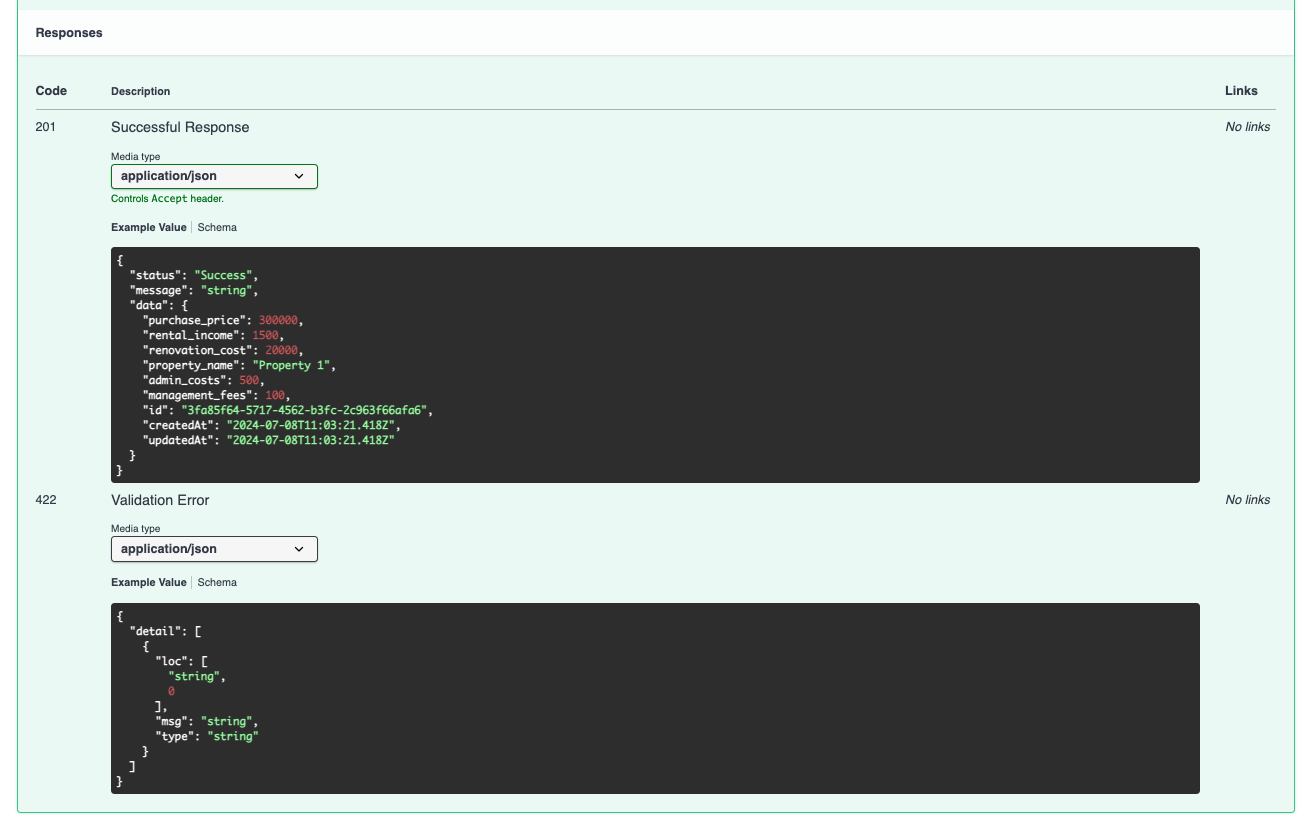
You could use the Swagger to perform initial tests however I prefer to use Postman given we can save the collection, use variables, etc.
Postman Collection
This article covers how to export your Swagger into Postman. You want to do this automatically instead of creating each endpoint manually.
You can even paste your raw Swagger file into the import option on Postman.
In Postman, navigate to your collection and set the baseUrl to localhost:8000.
You can now easily test the API endpoints.
HealthChecker
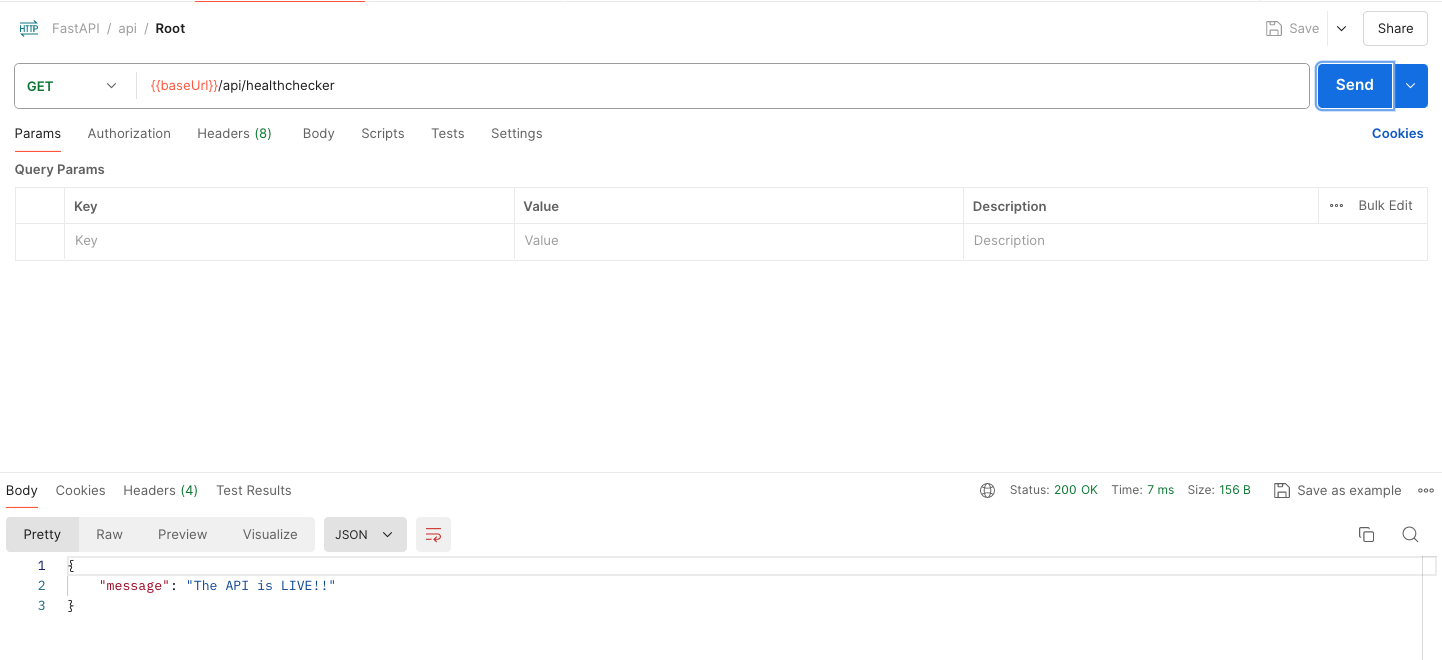
Create Property
It’s cool that the payload template is already available.
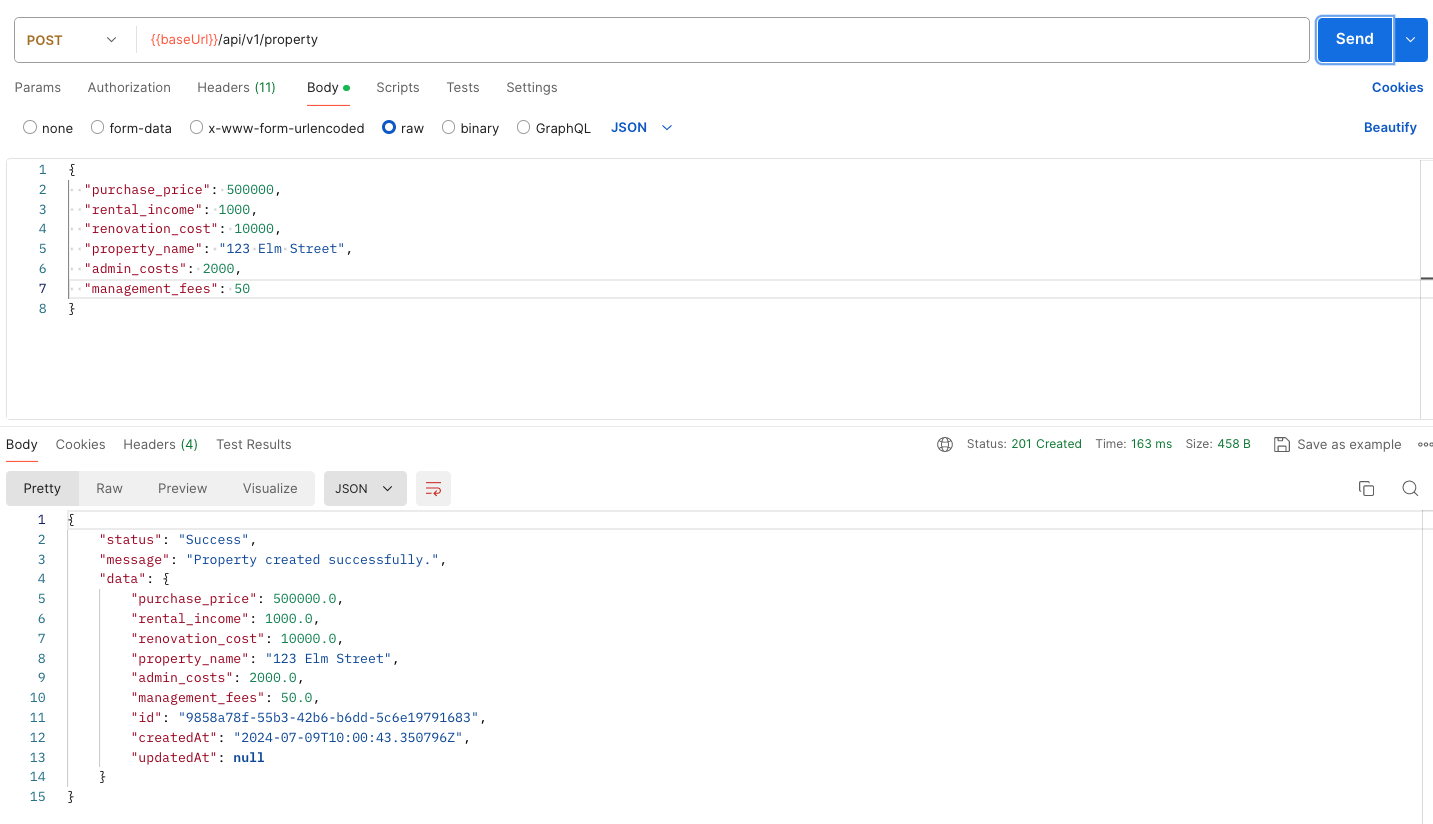
Get Property
Copy the id and add it to the GET request
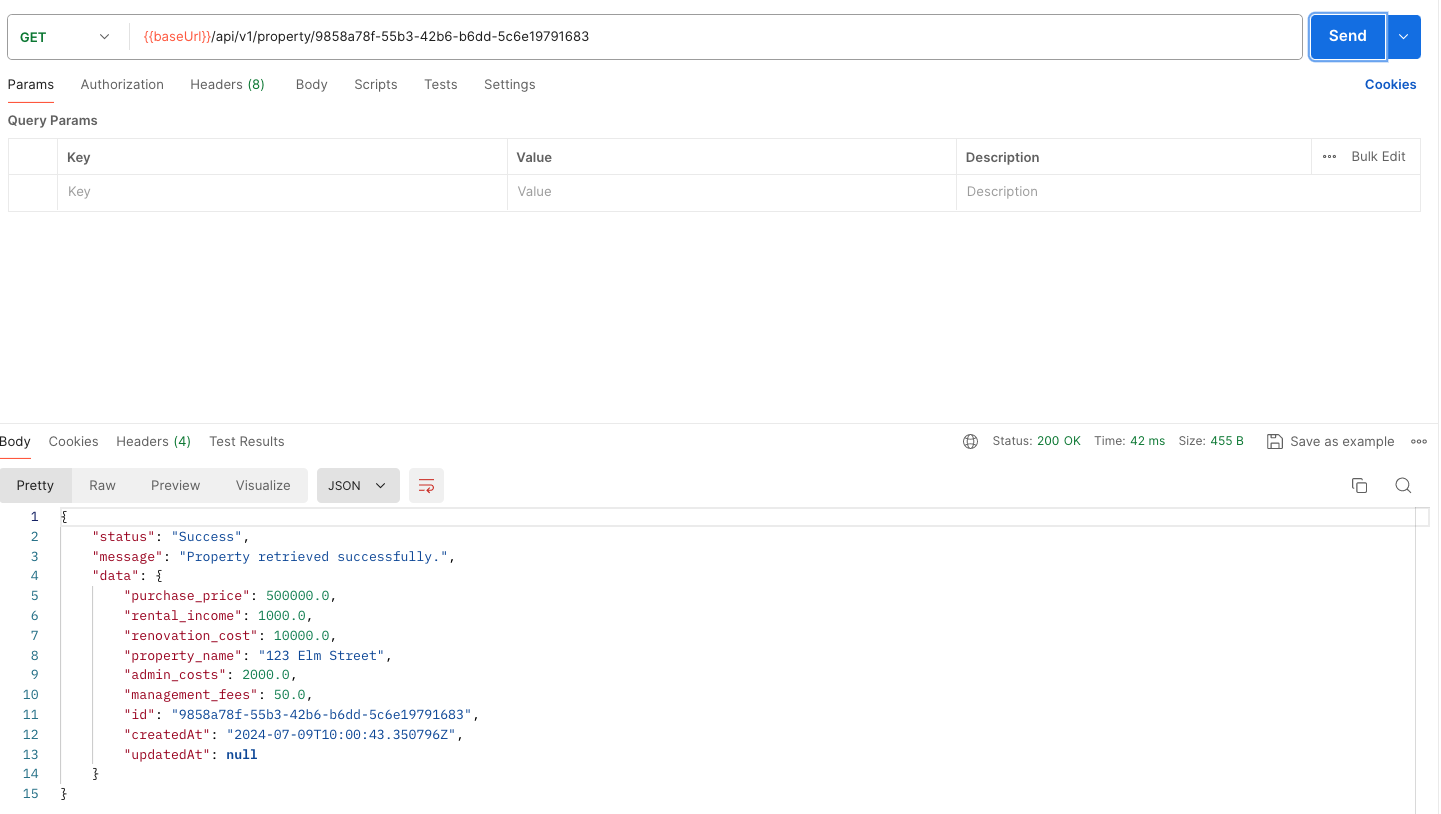
Update Property
Let’s update the renovation cost and management fees.
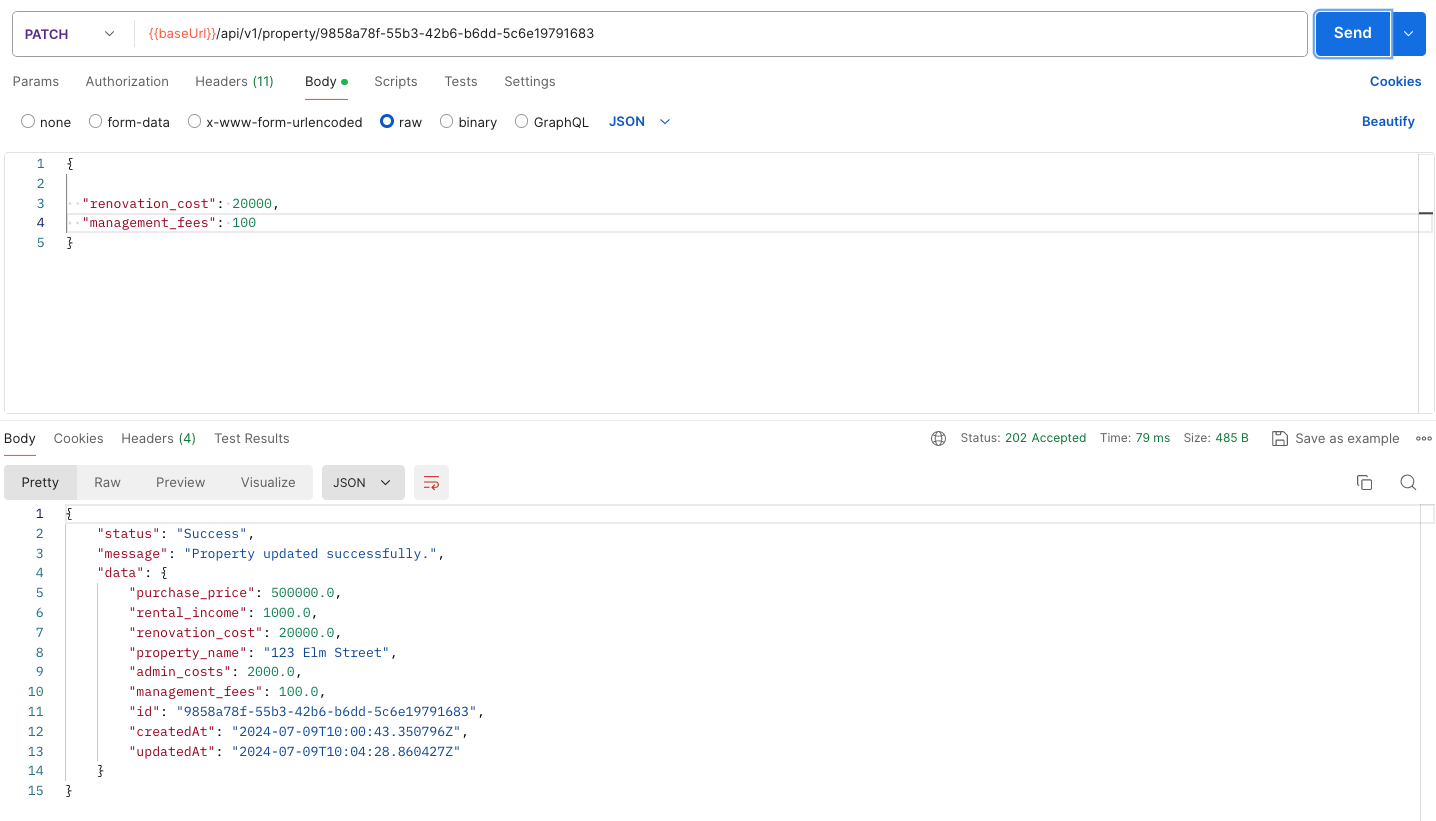
We successfully updated the 2 fields. Let’s do a GET property request just to make sure.
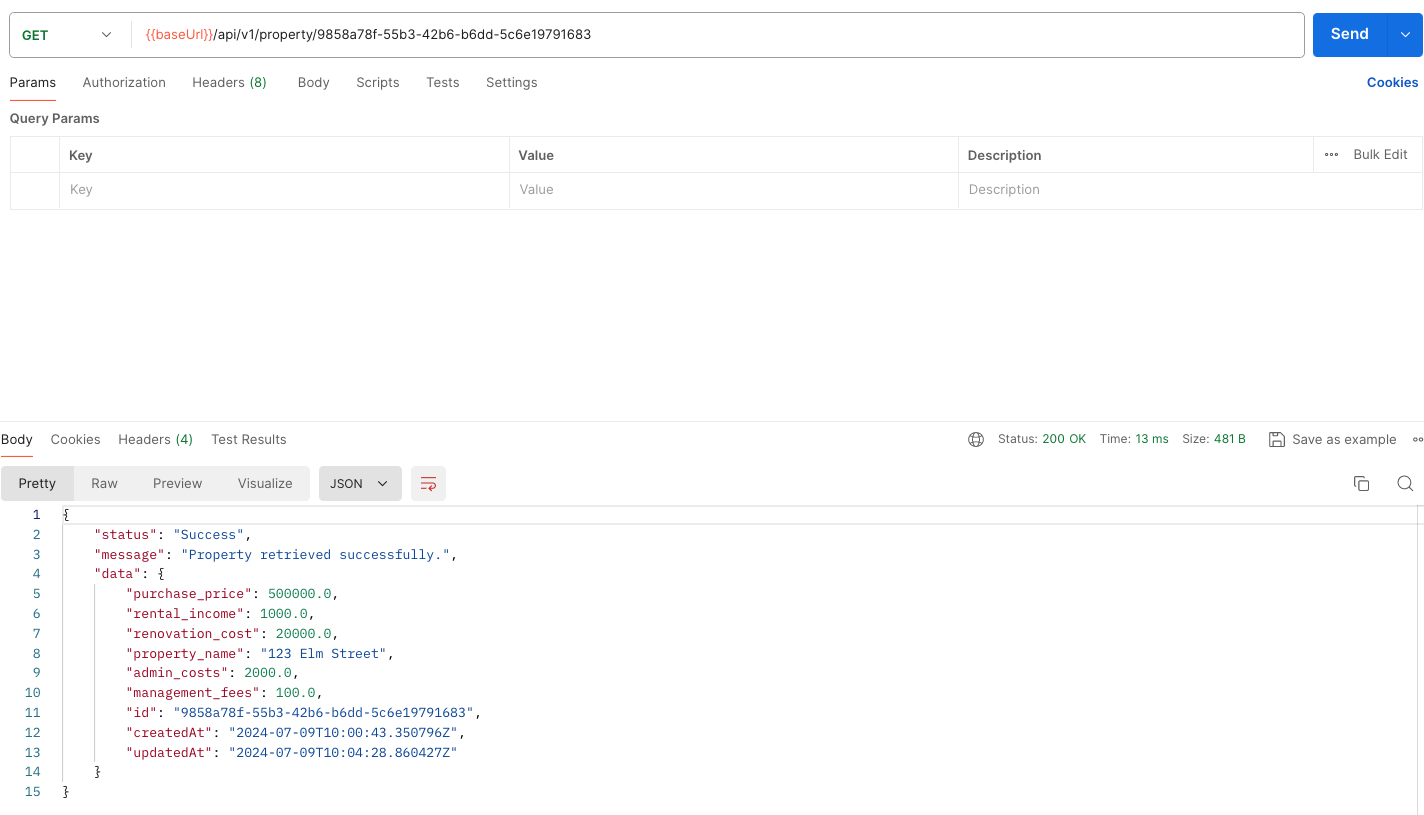
Yep, all good. Note the change to the updatedAt timestamp.
You can also set the property_id field as a variable within Postman.
Create Mortgage
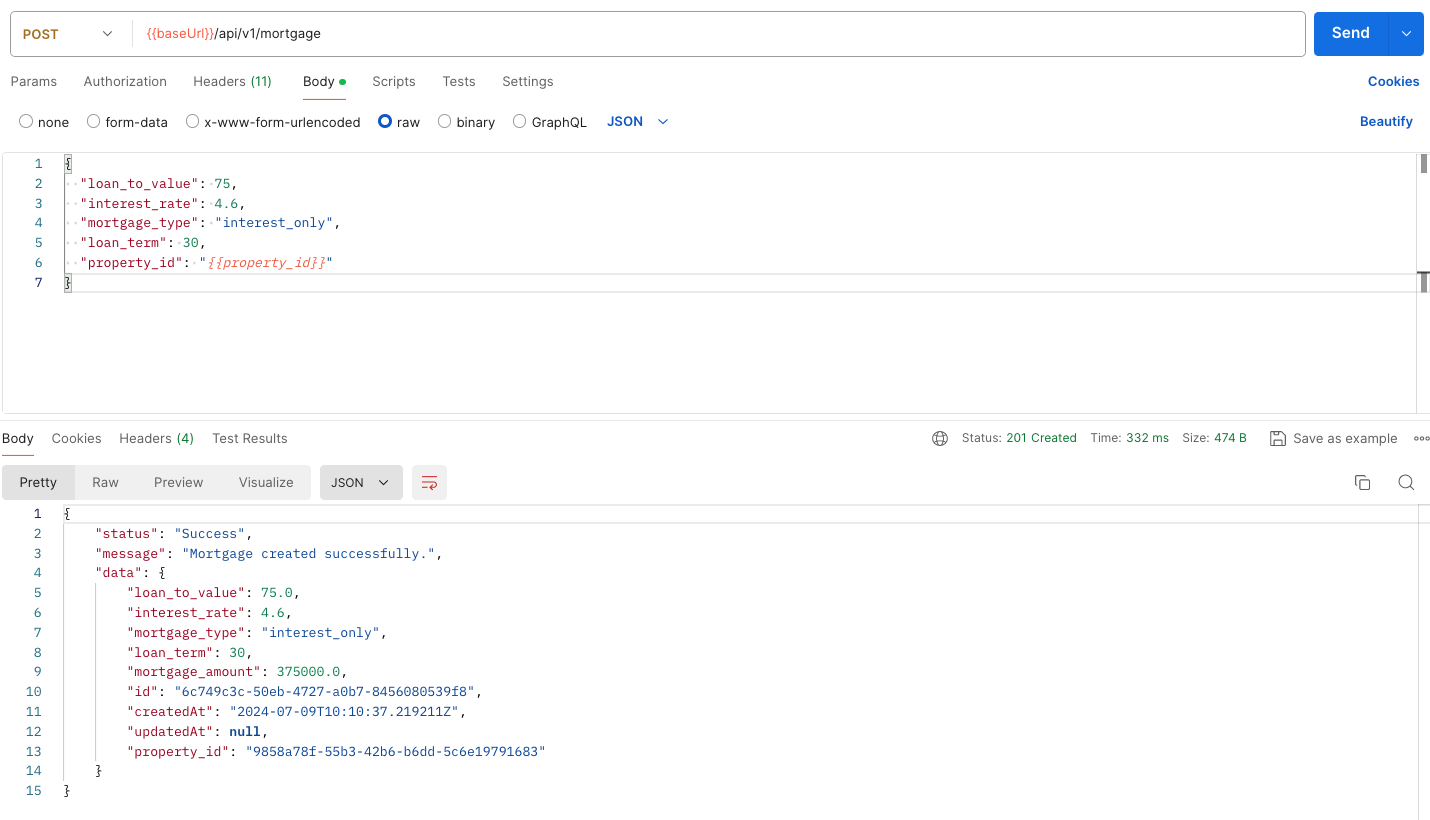
We can nicely use the property_id field within the payload.
Get Mortgage
Let’s get the mortgage to make sure it’s created correctly and references the property.

Note that I’ve set the mortgage_id as a Postman variable too.
You can see we’ve also calculated and stored the mortgage_amount in the backend which is 75% of 500,000 (375,000).
Calculate Mortgage Payment
How about we calculate the mortgage payment for this?

This can be quickly verified by1
2
3Monthly Payment = (Interest Rate * Mortgage Amount / 12)
Monthly Payment = (0.046 * 375,000) / 12 = 1437.50.
Which gives us confidence in our calculation.
Update Mortgage Interest Rate
Let’s say inflation has risen and so the Fed has increased rates to curb borrowing. It’s now risen from 4.6% to 6%.
We update the mortgage.
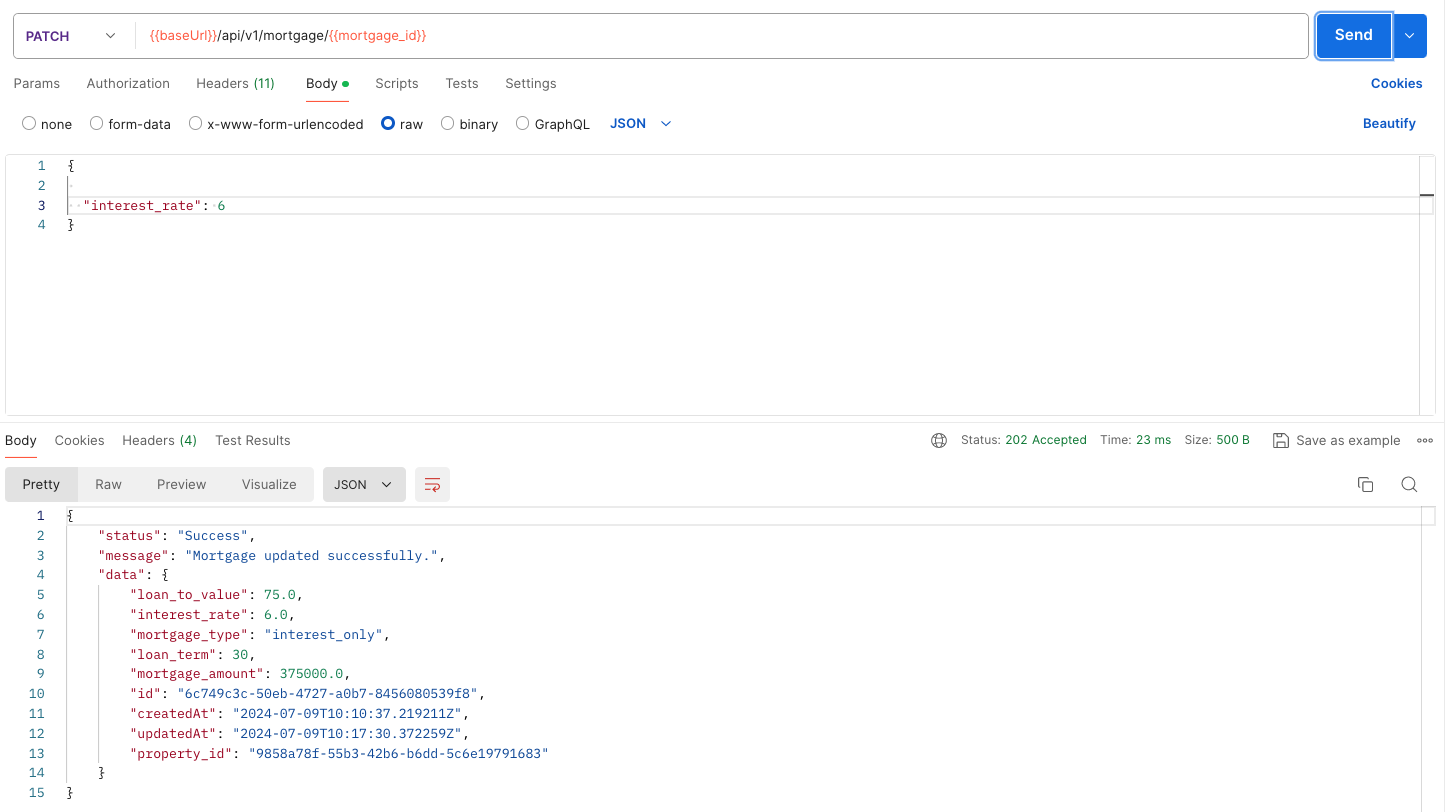
Calculate New Monthly Payment
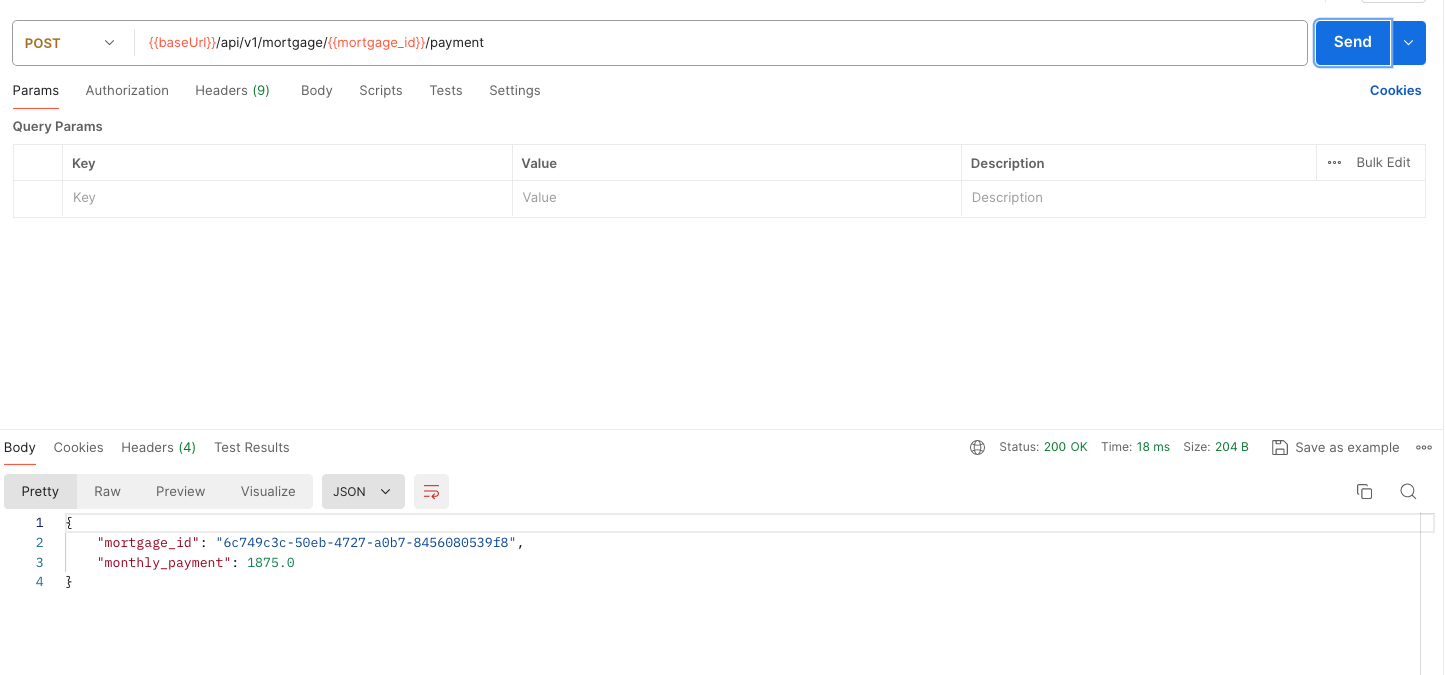
Our monthly payment has now gone up to 1875.0 (quite a steep increase).
Delete Mortgage and Property

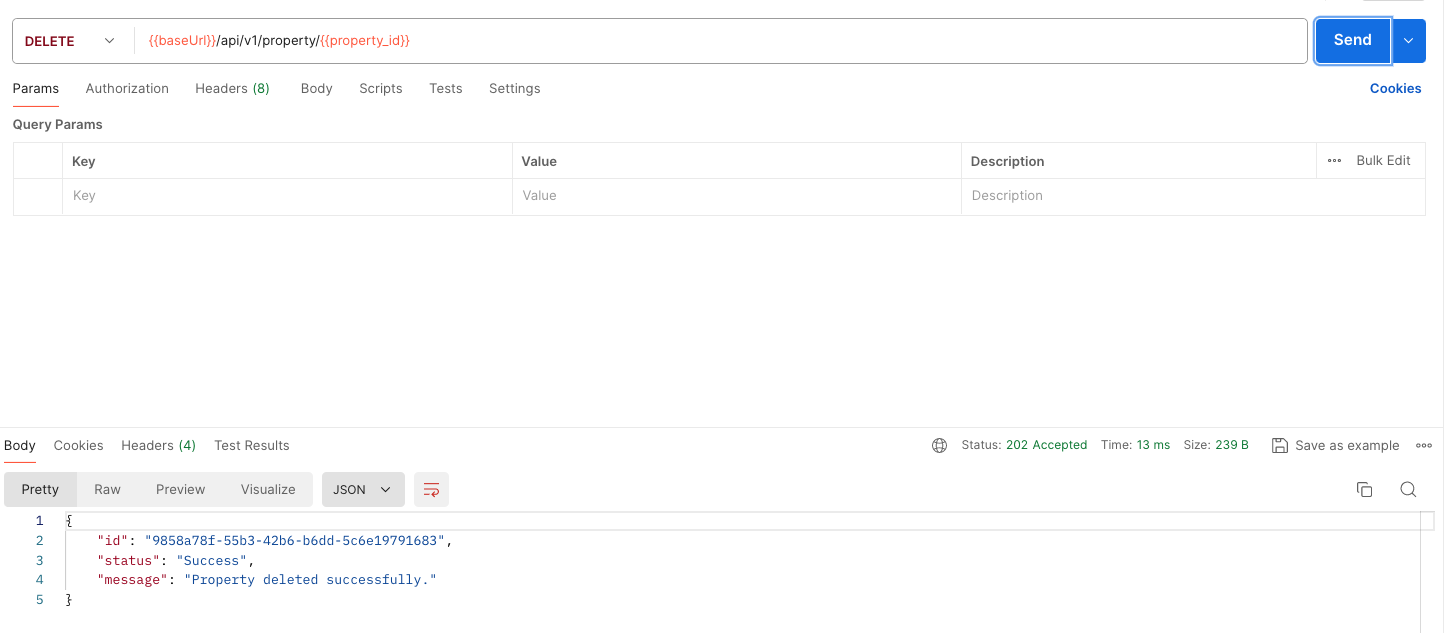
You can of course play around and delete a mortgage, add a new repayment type mortgage, and calculate the monthly payment.
We’ll cover this in the next article when writing tests.
Conclusion
OK this is it for article 1 of this 2 post series.
In this article, you learned the need for robust API testing and it’s importance.
Next we explored a fairly simple yet powerful Mortgage Calculator that allows us to create properties, associate a mortgage to that property and lastly, calculate the monthly payment.
You learned how to define SQLAlchemy ORM models for the 2 tables as well as Pydantic Models to handle objects and entities like Property and Mortgage.
Lastly, you learned how to define API routes and the importance of separating business logic from boilerplate API code.
We also learned how to export the OpenAPI JSON schema from the Swagger and import it into Postman to run our manual checks.
In the next article of this series, we’ll go deep into writing unit and integration tests to validate various workflows.
We’ll discuss whether you should mock the database, use an in-memory database like SQLite or use a full-fledged Postgres database.
Stay tuned for the next one.
If you have any ideas for improvement or like me to cover any topics please message me on Twitter, GitHub, or Email.
Till the next time… Cheers!
Additional Reading
Example Code Used in this Article: GitHub
How To Run Pytest With Poetry (A Step-by-Step Guide)
Maximizing Quality - A Comprehensive Look at Testing in Software Development
Building And Testing FastAPI CRUD APIs With Pytest (Hands-On Tutorial)
How To Test Database Transactions With Pytest And SQLModel
Python Unit Testing Best Practices For Building Reliable Applications
Comprehensive Step-by-Step Guide to Testing Django REST APIs with Pytest
13 Proven Ways To Improve Test Runtime With Pytest